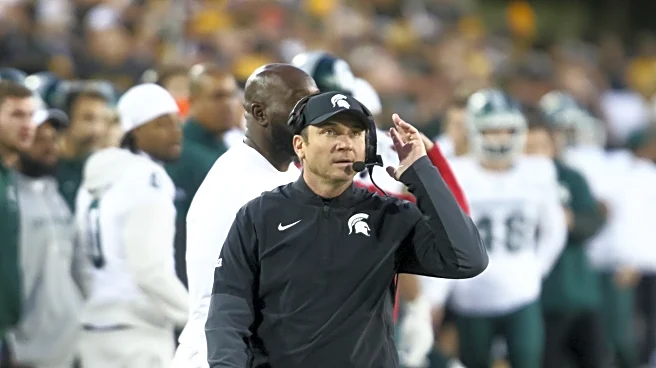If you were (un)fortunate enough to be able to watch the entirety of Michigan State’s 20-17 loss against the Iowa Hawkeyes on Saturday, you were blessed with an interesting case study of the Jonathan Smith
era at Michigan State University. On paper, Iowa is a team that is just a few plays away from being in College Football Playoff consideration, and MSU is a squad who has lost 8 in a row and remains winless in the Big Ten. However, between the whistles at Kinnick Stadium, it was the visiting Spartans who had more talent at more positions. The difference on the scoreboard is the same as the difference between the two programs: coaching decisions, experience, and ultimately, a winning culture. In today’s film review, we are going to break down the five plays that actually determined the outcome of this game, all of which went Iowa’s way. These five erased what was another strong road performance that once again ended in the Spartans losing by 3. I believe these plays, both individually and taken together, are a microcosm of all of the issues MSU football has under Jonathan Smith. Let’s dive in, from the beginning.
Play #1: 1st Quarter- 4:05 remaining
This game started slow, like a typical Big Ten conference showdown in Iowa City. While the offense sputtered, Joe Rossi’s defense once again showed major progress. After forcing two punts (and allowing zero completions) on the opening two drives by the Hawkeyes, senior Malik Spencer makes a huge play to intercept a Mark Gronowksi deep ball. After review, the Spartan offense takes possession, with all the early momentum on MSU’s side.
A pair of Brandon Tullis inside runs leaves Alessio Milivojevic and company faced with a 3rd and 2.

State comes out in a basic doubles set. Iowa counters with a 4-1 front, with four down linemen and one middle linebacker in the box. Brian Lindgren decides to throw the ball, and take advantage of Iowa’s single “Mike” backer. See below the red triangle around Iowa MLB, Jayden Montgomery signifying Alessio’s read.

Milivojevic signals to the RB Tullis, sending him in motion to the field on a quick “swing” route. Both of the wideouts to the bottom of your screen, Jack Velling and Omari Kelly, will block for Tullis, in some form of running back swing screen. To the boundary, Chrishon McCray and Nick Marsh will run a “slant/in” concept: with McCray in the slot on a slant route, and Marsh running a five-yard in cut from the outside.
How does Milivojevic know which side of the field to throw to? This is where our Mike LB in the red triangle comes into play. Offensive Coordinator Lindgren, in hopes to make things easier for his young QB, gives Alessio a simple middle linebacker read. All the Redshirt Freshman signal caller has to do is go to the side of the field opposite where Iowa’s Montgomery opens to.
Watch below as #36, our Mike backer, shifts to the field once Tullis leaves on his “tear” motion. This gives Alessio his answer, and even if the swing screen looks like it might have worked, he makes the correct read and finds an open man on the outside and throws a dart…

… And Nick Marsh drops it. Obviously, drops like this are something you never want to see out of your WR1, especially when they come on routine grabs like this one. For those of you who watched the game, it was clear that something was off with Nick Marsh. Look, I love #6 and I am grateful for his loyalty to MSU. However, when you are getting compensated monetarily as well as Nick is, have NFL aspirations like Nick does, and are undoubtedly the number one pass catcher on a team with a young QB, taking games off like what we saw Saturday are unacceptable. Marsh was dropping passes, jogging routes, and lazily missing blocking assignments. When a leader and player of his caliber is disengaged from the start, it is completely disheartening for a team. And in a game where one side of the ball is battling with everything it has, coming up with one key stop after another, that disconnect becomes impossible to ignore.
Beyond giving me a reason to rant about his disappointing performance, this above play served as a huge momentum swing as well. With the Marsh drop, MSU goes three-and-out following an impressive interception, surrendering any positive feelings gained from Malik Spencer’s toe-dragging play. To make matters worse, Iowa return specialist, Kaden Wetjen, promptly caught and returned Ryan Eckley’s ensuing punt for the game’s first touchdown. Wetjen’s return was a 360 degree flip in momentum, and the Hawkeyes were able to take the first quarter lead: without completing a single pass offensively.
Play #2: 2nd Quarter- 0:12 remaining
Our next play was almost hilariously flawed in terms of poor clock management. Allow me to set the stage.
MSU gets the ball back inside its’ own 15 with just over a minute remaining in the First Half. After a couple of completions to Velling paired with a few incompletions, State is faced with a 3rd and 10 on their own 42-yard line. Milivojevic throws to an open Chrishon McCray for a gain of 7 yards. For reference, the image below shows that there are 29 seconds left on the clock when McCray goes down.

Michigan State can do a couple things here, with 4th and 3 coming up. They can instantly call timeout and try to draw up a play that will get them in field goal range. Or State can let the entirety of the 40 second playcall run off, and take the 3-7 score into the half, if they are afraid of the Iowa offense getting the ball back with enough time to score.
In my opinion, the former is the better choice. You have lost 7 in a row, why not take a shot with your quarterback who had been slinging it. Regardless, I would have accepted the second choice as well. Instead, Coach Smith and co. decide to do neither. MSU lets the clock run down to 12 seconds before electing to use a timeout to discuss their fourth down playcall.

Wasting 17 seconds inexplicably is bad coaching. What is worse is the playcall and execution combination that ultimately would lead to an interception. Across Spartan Nation, fans were frustrated with the apparent call for a screen pass on this 4th and 3. I understand the complaint. Even if this play were to be successful, it is still a long developing play. State does not work the sidelines, does not go back to their tight ends who had the hot hand to this point, and overall makes the odds at getting in field goal range with time to spare very small. However, let’s set the record straight- this was not a called screen pass! The offensive line just gets beat that badly in pass rush!
The MSU offense is in fact trying to set up a variation of a mesh concept, with the running back leaking out to the field side. Velling and McCray will be running shallow crossers, attempting to get in the way of Iowa’s underneath defenders, while Nick Marsh will follow RB Tau-Tolliver’s flat route to the field, serving as Alessio’s second option. This play, often referred to as “Mesh Traffic”, is drawn up below:

Now why did this play look like a screen pass? Plain and simple, the offensive line getting beaten. With Elijah Tau-Tolliver releasing into a route, MSU has five blockers against Iowa’s four man rush. The protection called is a simple half slide left, drawn up below.

On the offensive left, both center, guard and tackle are instructed to slide to the gap to their left, and account for the two Iowa defensive linemen to the boundary. To the right, both RG and RT are “manned up” against the field defensive linemen. So, half the line is zone sliding, while the other half is in man protection; hence, the name, a half-slide protection.
We’ll start by watching the offensive line. See below as Rakeem Johnson (RG) and Conner Moore (RT) both get beat in their man-to-man assignments, and fluster Alessio into a backpedal. This push from the Hawkeye front gives this play the appearance of a screen pass, just without the Spartan O-Line releasing to block for the RB.

Alessio feels the pressure and has to get rid of the ball, which falls into the hands of the Iowa defensive backfield. Here is the same play from the usual wide view.

From this angle, watch how Chrishon McCray’s attempt at picking the linebacker flowing with Tau-Tolliver actually results in his defender sniffing out the flat route.
Poor clock management, poor playcall, and poor execution. These all lead to an unnecessary turnover, and set up the Hawkeyes with great field position (even though Iowa would miss the field goal). Sounds about right for this dysfunctional 2025 team.
Play #3: 4th Quarter- 2:55 remaining

This next disaster of a play is a simple one. Let me ask all of you- would you punt the ball, late in the Fourth Quarter, clinging to a one-score lead, to Iowa’s established playmaker of a punt returner?
To be fair, Jonathan Smith did claim postgame that punter Ryan Eckley was instructed to put the ball out of bounds. Now, not to call Smith a liar, but blaming arguably your team’s best player and the national leader in punt yardage? Not sure if I love that answer.
Maybe it was truly on Ryan Eckley. Maybe he was afraid to aim out of bounds, because the last kick he had that went out of bounds was a shank off his foot that set Iowa up with great field position. Maybe a strong wind gust blew through Iowa City and kept this ball in bounds. All things that could have happened, but I cannot answer for you.
What can I answer? What went wrong on this special teams fiasco. To begin, here is a look at the protection responsibilities of the Spartan punt unit.

Notice how the protection is all sliding to their left, towards the boundary. While this is fortunately effective in preventing the Hawkeyes from blocking Eckley’s boot, it also sends all of MSU’s potential tacklers for Kaden Wetjen clustered near the sideline. All the talented returner has to do is reverse field to his right and State’s left; and he only has one or two men to beat.
Additionally, we hear it all the time with punts, that it is harder for coverage teams to make a quick tackle when the punter overshoots the expected distance set by the returner. Why is this? First of all, it gives the speedy Wetjen a much greater cushion between himself and the first Spartan gunners to arrive, making it easier for him to make a move. Secondly, the coverage team overpursues and is unable to make the play quickly.
Watch below as the out-kicking of the punt coverage, and protection slide right combine to give Wetjen a huge lane to make an explosive and effective return.

Several of you all in our Game Thread asked this question, but I’ll pose it again. WHY ON EARTH ARE WE KICKING HIM THE BALL? Smith and the rest of the staff had been incorporating the Quarterback quick punt all game, why not use it here to avoid, well, what happened? Once again, a questionable coaching decision leads to a backbreaking play that could have been easily avoidable. Sound familiar?
Play #4: 4Q 2:33- remaining
I hate to pick on the defense. I really do. I would much rather review one of the several 3rd down stops the defense had early on, or one of the turnovers generated. Rossi has done a great job with the defensive unit, and it has been night and day since the DC decided to come down from the field and coach from the sidelines.
That being said, a similar theme has proven true alongside this defensive resurgence: late game lapses. In the losses to Minnesota, Penn State, and now Iowa, we have seen the defense crumble in the biggest moments late in the game. The most decisive one at Kinnick Stadium? Mark Gronowski’s 16-yard 2nd down scramble that set up the Hawkeyes’ tying score.
With 2:33 left in the 4th Quarter and faced with a 2nd and 10, Iowa calls a quick game passing concept. The Spartan defense dials up a surprise pressure, with Malik Spencer blitzing from his free safety spot.

This pressure should work perfectly. Iowa’s Offensive Line, as signified by the red lines, is in a full slide protection to their left, and Spencer should come unlocked off the right edge.

This is exactly what happens. One small problem. Spencer comes in too hot, cannot break down, and Gronowski scampers for 16 yards. Malik has been a solid piece for MSU for several years now, but this is one of these big time plays that are required to be made if you want to win in the Big Ten.
While this is definitely more of a physical mistake than a coaching one, I definitely would have appreciated a QB spy being called on Gronowksi late in the game, knowing that the Iowa quarterback’s biggest strength is his legs.
Just like this game overall, this play was there for the taking. Just like this game overall, MSU cannot deliver and make the most of this opportunity. First down Hawkeyes, leading to a touchdown and later a win for the black and yellow.
Play #5: 4th Quarter- 0:51 remaining
To wrap up, let’s fast forward to Michigan State’s last drive of the game. In fact, let’s go to MSU’s last offensive play. Stop me if the following sounds familiar: 3rd and 2, a doubles or 2×2 set, with a tear motion from the running back. Need it in visual form? See if the play below rings any bells.

A swing screen to the field, accompanied by a slant and in route from the boundary. The very same concept as the first play we broke down today. Yet again, this play has a chance to be successful, and is not.
This time, Iowa is in a “6-up” look, with six men showing pressure at the line of scrimmage. This should not be an issue, as this route combination gives Alessio quick options to both sides. Milivojevic makes a similar read, and after seeing Iowa’s middle linebacker take off with the running back’s tear motion, he gets his eyes on the boundary side. The Hawkeyes have both McCray and Marsh in press coverage, and this makes creating separation much more difficult for the Spartan wideouts.

Yes, this play is probably pass interference against Chrishon’s defender. Watch the ref on the left hash duck out of the way and miss throwing the flag. Despite this blown call, there is an even more telling part of this unsuccessful play. Watch Nick Marsh run a great, physical route to the top of your screen, and create more than enough separation. Alessio, though, does not even look Marsh’s way. This is what happens when you pick and choose when to hustle and when to loaf, your quarterback loses trust and faith in you, and you let your team down even in the biggest moments when you decide to flip the switch.
Much like the rest of the team, we Spartan fans need to see a more consistent version of Nick Marsh. A player of his degree can make such an impact on any game, and the fact that on Saturday afternoon, this impact was a negative one was extremely noticeable.
Immediately following this play, the Spartans would decide to punt again. And once again, I am going to question that decision: what do you have to lose by going for it? After blowing a 10-point lead and only possessing the ball for a total 4 minutes and 16 seconds the entire 4th quarter, keeping the offense on the field for 4th down would have been the right decision. Maybe not the analytically sound choice, but a statement that tells your team that the coaching staff has just as much fire and will to win as the majority of players on MSU’s roster exhibited on Saturday.
Instead, State punts, all but waving the white flag, allowing Iowa to take the win a few plays later on the field goal winner.
Takeaways and Looking Forward
When you zoom out from these five moments, a clear picture forms. Michigan State has not lost these last few games because it lacks talent. The Spartans have had better quarterback play, more explosive weapons, and a defense that is leaving nearly everything on the field. What they lack is the ability to finish, avoid self-inflicted wounds, and make the handful of winning plays that separate competitive teams from successful ones.
These breakdowns are not random. They are symptoms of the same issues that have defined Jonathan Smith’s time in East Lansing so far: questionable game management (decisions made in the Minnesota and um games), inconsistent effort (UCLA game), and a team that still hasn’t figured out how to close out a winnable Big Ten game (too many examples to name). That’s how you outgain an opponent 335 to 301, control 90% of the game, and still walk away with your eighth straight loss.
Now, I ask you, TOC nation. What key plays did I miss? What other issues do you have with Smith and staff? Which of these last three games have been the most heartbreaking for you, or are you like me and numb to the losses at this point? Let me know in the comments, and have a Happy Thanksgiving! I will see you all for our final football Film Room next week (I am thankful for the end of this football season being less than a week away).














